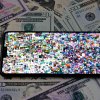- Date
- 17 March 2021
Far From Everyday: Beeple NFT Collage Breaks Christie’s Record
Far From Everyday: Beeple NFT Collage Breaks Christie’s Record
By Alison Catchpole |
The Story
“When you think of high-valued NFTs, this one is going to be pretty hard to beat,” proclaimed Metakovan, chief financier behind the largest Non-Fungible Token (NFT) fund in the world Metapurse (Bloomberg). He paid US$69.3 million – using cryptocurrency Ether, naturally – for a digital file. It was the third most valuable artwork ever sold by a living artist, behind Jeff Koons and David Hockney, and the first purely digital NFT artwork offered for sale by a major auction house (Christie’s).
So, what is a non-fungible token? Well, let’s start with the question: 'What is fungible?'. If something is fungible, put very simply, it can be readily exchanged or substituted. Think of a £10 note – you can easily replace it with another £10 note, or even two £5 notes, and it still holds value. On the other hand, if something is non-fungible, it’s unique and irreplaceable. Take the Mona Lisa for instance. A photo of the Mona Lisa isn’t the same thing as the original painting.
Now, back to the story. American graphic designer Mike Winkelmann, aka Beeple, has shared a new image on his Instagram feed @beeple_crap daily since early 2007. When Covid-19 struck, exploring the world of cryptocurrencies and blockchains led him to NFTs, a digital representation of an asset providing a digitally traceable certificate of authenticity. Winkelmann threaded his Instagram images together to create a work of art. The resulting NFT, ‘Everydays: The First 5000 Days’, charts his evolution as an artist over the past 13 years. “I almost look at it now like I’m a political cartoonist… using the most advanced 3D tools to make comments on current events, almost in real-time,” Beeple told Christie’s.
For buyers seeking provenance, authenticity and scarcity, NFTs deliver. They can represent things (real estate, tweets, other assets), or like art, they can be the things. Collectors seem hooked: in a recent venture between the US National Basketball Association and consumer blockchain company Dapper Labs, a 12-second encrypted clip of basketball legend LeBron James sold for $208,000 (Financial Times). Meanwhile, Twitter founder Jack Dorsey has put his first tweet up for sale as a NFT, with the highest current bid at $2.5 million. Then there was the case of the 500 limited-edition Banksy prints entitled ‘Morons’ being burned, shown on YouTube. The NFT token created sold for US$382,000, over three times the cost of the original.
What It Means For Businesses And Law Firms
NFTs have been around since 2010 but a craze emerged in 2017 through limited-edition digital cats ‘CryptoKitties’ which could be bought and ‘bred’. In 2018, Cooley successfully advised Axiom Zen on a trade secret lawsuit filed by Starcoin alleging that CryptoKitties had stolen the idea for a celebrity partnership – an early indication of the role of promotion in this new form of asset.
NFTs present challenges – especially for Intellectual Property lawyers and those focused on art theft. How should they fit into existing financial, technology and cryptocurrency regulation? An image can be replicated but an NFT cannot. The artist can still retain the copyright and reproduction rights – but MarbleCard is an NFT platform allowing users to make and trade tokens representing web pages (Guardian). Tokenized Tweets enables someone else to tokenize and sell a tweet or image without the permission of the original Twitter user or artist. Both buyers and sellers need to keep a close eye on whether what they bought matches the ‘legal reality’ (Coindesk).
As with art, multijurisdictional tax regimes may impact on transactions. Laws which prevent business being conducted with sanctioned nations, or by sanctioned entities, could also be difficult to track and adhere to, as happened on the Marine Chain ICO (Coindesk). ESG is another concern with “a single NFT transaction …ecologically equivalent to a 2-hour flight or an EU resident’s electricity consumption for 1 month” (OfDollarsAndData). Who knew that spending money could cost so much.
Image Credit: mundissima / Shutterstock.com
